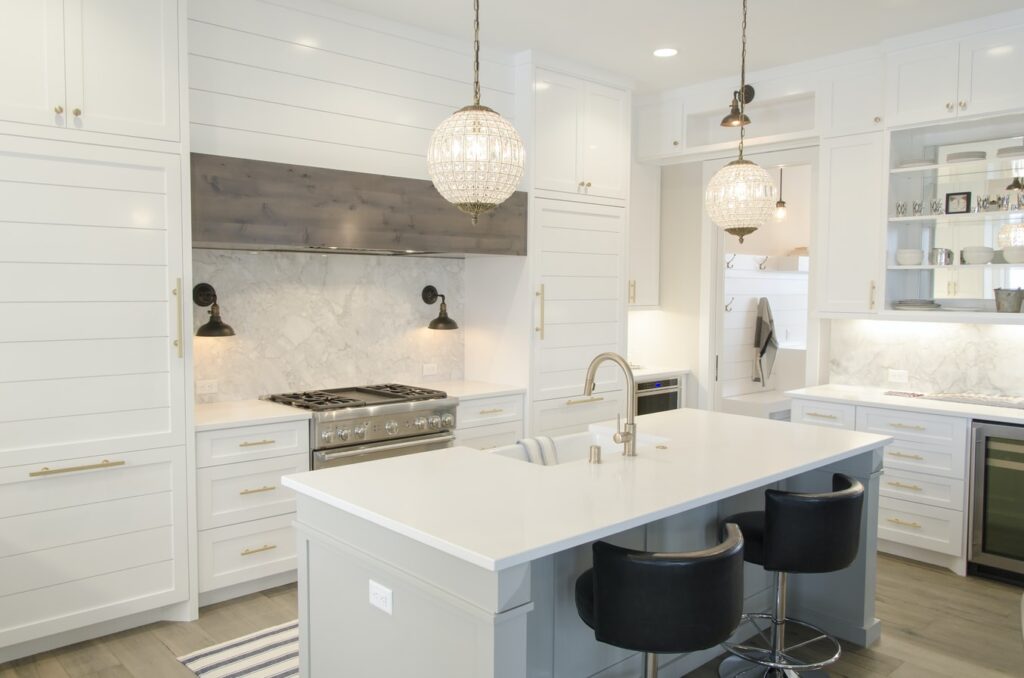These specifications are kitchen remodeling suggestions – your Sparta Trades Kitchens & Baths designer can help you work through what is best for you and your family.
Door Interference
Entry door should not interfere with safe appliance operation or appliance doors.
Distance Between Work Centers
With three work centers, the total distance traveled should not be more than 26 feet with no single leg of the triangle less than 4 feet or more than 9 feet.
With more than three work centers, each additional travel distance to another work center should be no less than 4 feet or more than 9 feet. Each leg is measured from the center-front of the appliance/sink. No work triangle leg should intersect an island/peninsula by more than 12 inches.
Separating Work Centers
A tall obstacle should not separate two primary work centers. A properly recessed tall corner unit is acceptable.
Work Triangle Traffic
Major traffic patterns should not cross through basic work triangle.
Work Aisle
The work aisle should be at least 42″ for one cook and at least 48″ for multiple cooks.
Walkway
The walkway width should be at least 36 inches.
Traffic Clearance At Seating
Allow 32 inches of clearance from the table to wall/obstacle if no traffic passes behind a seated diner. If traffic passes behind the diner, allow at least 36 inches to edge past or 44 inches to walk past.
Seating Clearance
30 inches high tables/counters should allow a 24 inches wide by 18 inches deep space for each seated diner.
36 inches high counters should allow a 24 inches wide by 15 inches deep space for each seated diner and at least 15 inches of knee space.
42-inch high counters should allow a 24-inch wide by 12-inch deep space for each seated diner and at least 12 inches of knee space.
Cleanup/Prep Sink Placement
With only one sink, locate it adjacent to or across from the cooking surface and refrigerator.
Cleanup/Prep Sink Landing Area
Include at least a 24-inch landing space on one side of the sink and 18-inch on the other.
If all the countertop at the sink is not the same height, plan a 24-inch landing space on one side of the sink and 3 inches of countertop frontage on the other, both at the same height of the sink.
Preparation/Work Area
Include a section of countertop at 36-inch wide x 24-inch deep next to the sink for a work area.
Dishwasher Placement
The nearest edge of the dishwasher should be within 36 inches of the nearest edge of sink. Provide at least 21 inches of standing space between the edge of the dishwasher and countertop frontage/appliances/cabinets which are placed at a right angle to the dishwasher.
Waste Receptacles
Include at least 2 waste receptacles, one near the sink and the other nearby for recycling.
Refrigerator Landing Area
Include at least 15 inches of landing area on the handle side of the refrigerator, 15 inches on either side of a side-by-side refrigerator, 15 inches of landing space which is no more than 48 inches across from the front of the refrigerator, and 15 inches above or adjacent to any under counter-style refrigerator.
Cooking Surface Landing Area
Include at least 12 inches of landing area one side of the cooking surface and 15 inches on the other.
If cooking surface is at a different countertop height than the rest of the kitchen, then the 12-inch and 15-inch landing areas must be the same height as the cooking surface
For safety reasons, in an island or peninsula situation, the countertop should extend a minimum of 9 inches behind the cooking surface if the counter height is the same height as the cooking surface.
Cooking Surface Clearance
Allow 24 inches between the cooking surface and a protected noncombustible surface above it.
At least 30 inches of clearance is required between the cooking surface and an unprotected/combustible surface above it.
If a microwave hood is used, then the manufacturer’s specifications should be followed.
Cooking Surface Ventilation
A correctly sized, ducted ventilation system is recommended for all cooking surface appliances. The recommended minimum is 150 CFM.
Code requires that the manufacturer’s specifications be followed. Minimum exhaust rate for a ducted hood is 100 CFM and must be ducted to the outside.
Make-up airway may need to be provided. Refer to local codes.
Cooking Surface Safety
Do not locate cooking surface under an operable window. Window treatments above cooking surface should not use flammable materials. Place a fire extinguisher near the kitchen exit away from cooking equipment.
Microwave Oven Placement
The ideal location for the bottom of the microwave is 3 inches below the principle user’s shoulder, but no more than 54 inches above the floor.
Microwave Landing Area
Provide at least 15 inches above, below, or adjacent to the handle side of a microwave oven.
Oven Landing Area
Include at least 15 inches next to or above the oven. A 15-inch landing area that is not more than 48 inches away is also acceptable as long as the oven does not open into a walkway.
Countertop Edges
Clipped or round corners rather than sharp edges are recommended on all counters.
Storage At Cleanup/Prep Sink
The recommended total for a small kitchen is 400 inches, a medium kitchen is 480 inches, a large kitchen is 560 inches and should be located within 72 inches of the centerline of the main cleanup/prep sink.
Corner Cabinet Storage
At least one corner cabinet should include a functional storage device.
Electrical Receptacles
GFCI (Ground-Fault-Circuit-Interrupter) protection is required on all receptacles servicing countertop surfaces within the kitchen.
Lighting
Every work surface should be well illuminated. At least one wall switch-controlled light must be placed at the entrance.
Window/skylight area, equal to at least 8 percent of the total square footage of the kitchen, or a total living space which includes a kitchen, is required.
